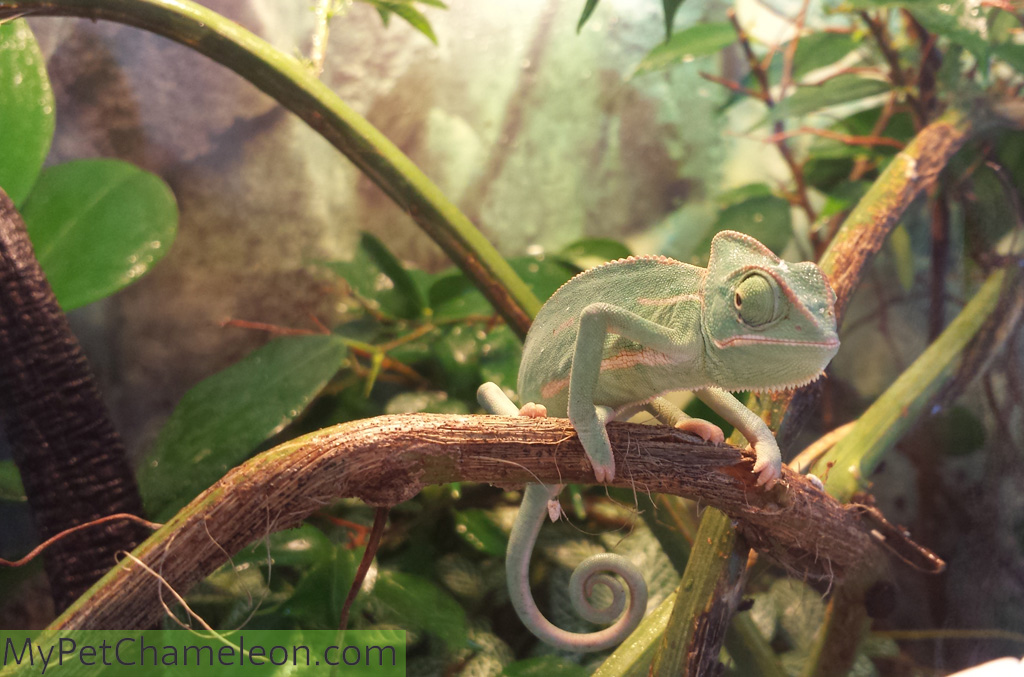
A chameleon can be kept in a terrarium or a net cage. A terrarium is made from glass and some mesh and provides the chameleon with air flow, air humidity, the correct temperature, enough space to walk around and protection against draft. A net cage is an enclosure completely made from mesh or netting. It provides enough ventilation, but in most climates it is not suitable for Yemen chameleons as it does not supply enough air humidity and temperature. To read more about what I have against net cages, check out the page about ventilation.
The proper housing really makes a world of difference for a chameleon. Its terrarium makes the difference between growing up to be a sad small creature or a colorful, active and healthy chameleon.
After the age of 3 months veiled chameleons should be housed alone. To read more about this, read Should my chameleon be housed alone?

Size of the terrarium
The terrarium should be big enough, so the chameleon can walk around, climb and hide in (fake) plants. It will also be able to choose to be perched under its heat lamb or not, allowing it to manage its body temperature better. A chameleon terrarium should be taller than wide. For an adult veiled chameleon the terrarium should be around 1,20 x 1 x 1 meter (height x width x length). Do not choose a smaller terrarium than 0,80 m by 0,60 m by 1 m for an adult.
Young baby chameleons do not need such a big enclosure. Especially if you do not hand feed them, as it is difficult for the chameleon to find live insects in a large terrarium. Let the terrarium grow with the size of your chameleon, or just hand feed a baby chameleon in a big terrarium.
Setting up the terrarium with decoration
Its just as important that you decorate your terrarium properly than the size of it. Branches, fake plants or live plants and a nice background will help you terrarium look great and will allow your chameleon to walk around, look for prey, hide from sight if it wants to and choose where to hang out. Especially at night a veiled chameleon would prefer to hide in between leaves to sleep. It greatly reduces stress if you provide it with enough places to do that.
Live plants can be a hassle to maintain, but they are the best for your chameleon. Not only do they look good, they also increase the air humidity inside the terrarium which benefits the chameleon a lot. Plants that are suitable for chameleons are for example ficus, umbrella tree, small palms, dracaenas, ivy or philodendron. Other plants can be used as decoration, like ferns and bromelias. You will find many at reptile fairs or in garden centers. The only plants that are obviously not suitable are plants with thorns or sharp leave sides and poisonous plants. Rinse the plants with lukewarm water before placing them in the chameleons terrarium.
Branches or vines are great for your chameleon to climb on. You can buy them or collect them from nature. Wash them with very hot water to kill any pathogens. Different sized branches are the best. You can add fake plants like ivy to decorate parts of the branches to give them a natural look. Fix the plants well, as your chameleon can fall down together with those (fake) plants and hurt itself.
The bottom of the terrarium should be covered with coco peat or garden soil. Its better not to get your own soil from the garden as it is full of worms, bugs, bacteria and fungi. Do not use tree bark pieces or wood chips at the bottom of a terrarium for a chameleon. It can accidentally pick up these pieces when trying to catch prey with its tongue, when ingested this can be fatal.

Temperature, humidity, light and ventilation
Just the terrarium or enclosure with some decoration is not enough. You need to set it up in a way that it will provide for the needs of your chameleon. To read more about the things a chameleon needs in his environment, check out the next topics:
